Return to Homepage
HOW A DYNAMO IS
CONSTRUCTED
A Dynamo is a machine for converting rotary motion
into electricity.
The usual form of dynamo consists of a circular
metal frame which is magnetised so as to create a strong magnetic
field across the internal space.
|
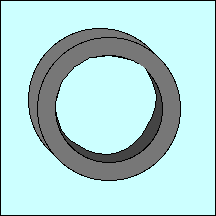
|
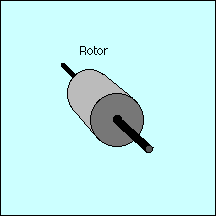
|

|
|
The frame is made of a ring of
magnetisable iron or steel alloy
|
Inside the ring is the 'rotor', a
cylinder of metal which can rotate.
|
Pole pieces made of magnetisable iron are
also fixed to the inside surface of the ring
|
|
Coils of insulated electric wire are
wound on the pole pieces
|

|
|
|
When an electric current is passed
through the coils, it cause the pole pieces to become
magnetised. The magnetism flows easily through the ring
which joins the backs of the pole pieces, but from the face
of each pole piece it has to jump an air gap to the rotor
and across to the opposite pole.
This means that the rotor is in a very
strong magnetic field, but is still free to
rotate.
|

|
|
The rotor is wound with a coil of
insulated wire which rotates with it.
(The way a connection is made to this
rotating coil wiil be explained later)
|
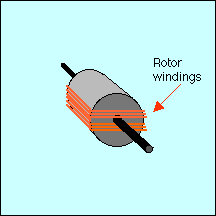
|
|
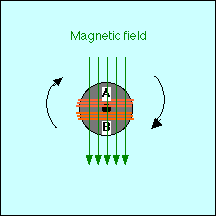
|
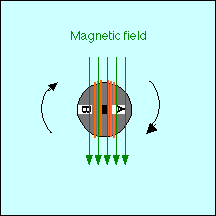
|
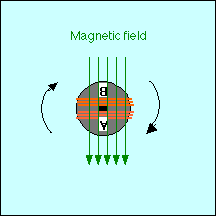
|
|
As the coil rotates in the magnetic
field, the magnetism passes through the coil
first from A to B, then from B to
A. The coils sees a constantly changing magnetic
field, even though it is the coil which is moving, not the
field..
|
|
If we have two electrical terminals fixed
to the rotor at A and B, we can connect the
two ends of the coil to them.
When the magnetism in the coil changes, it will cause a
voltage to appear between the terminals.
This voltage depends on the rate of change of the
magnetism, not on its actual value
|
|
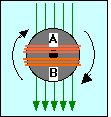
|

|

|
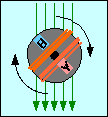
|
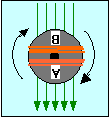
|
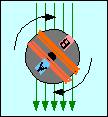
|
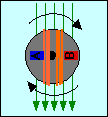
|

|
Strong magnetism
but no change
|
Changing
|
Greatest rate of change
|
Still changing
|
Strong magnetism
but no change
|
Changing the other way
|
Greatest rate of change
|
Still changing back
|
|

|
This
voltage is said to be Alternating, it
regularly cycles from one direction to the other.
Alternating current is useful for some
things and Direct current is useful for others.
Depending on how we make the connection to the rotating coil, either
alternating or direct current can be supplied.
|
ALTERNATING
The current can be picked up by carbon
brushes rubbing on a set of copper slip-rings. Each
brush is continuously connected to the same end of the
coil
|
DIRECT
The current can be picked up by carbon
brushes rubbing on a commutator, which is a drum made
of copper bars (insulated from each other). Each brush is
connected first to one end of the coil, then to the other,
as the rotor revolves
|

|

|
|
With slip-rings making the connection,
the positive supply alternates from terminal to terminal,
giving AC
|
With commutator bars making the
connection, the connections are constantly being swapped so
that the positive terminal is always connected through a
brush to whichever end of the coil happens to be positive at
any particular moment. This gives
DC
|
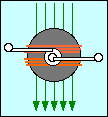
Alternating
current
|
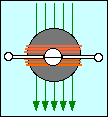
Direct Current
|
|
|
Direct current is preferred for
tramways for, a number of reasons
|
|
Commercially-built dynamos for tramways
have several pole pieces, many coils on the rotor and a
complex system of brushgear for picking up the
current
|
|
|
|
|
In early power stations, the dynamos were driven
by endless ropes or belts from the flywheel of the steam engine. By
choosing appropriate pulley sizes, this allowed large slow steam
engines to drive smaller faster dynamos. Later the steam engines were
designed with better lubrication to suit to higher speeds and the
dynamos could then be coupled directly to them.
Return to Track and Vehicle Homepage





















